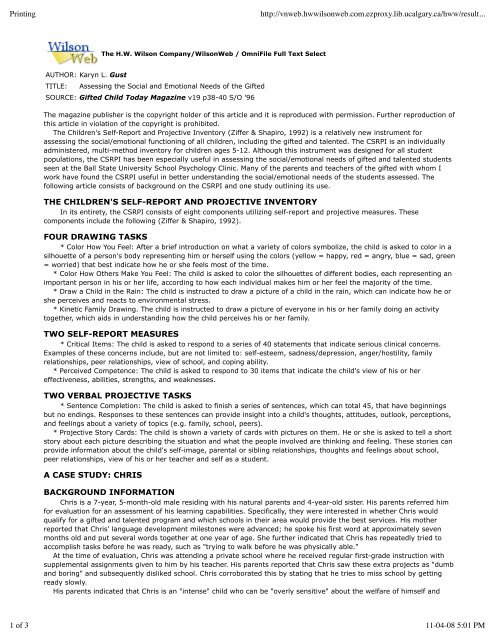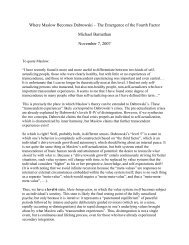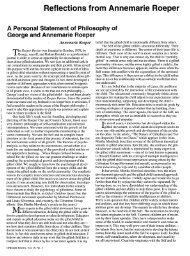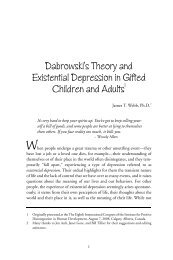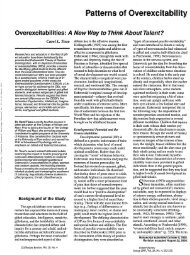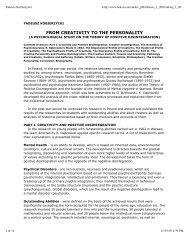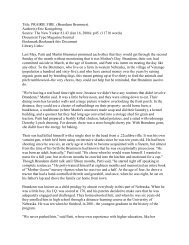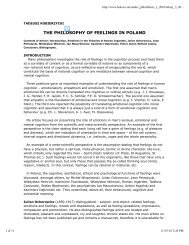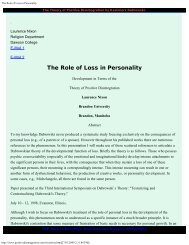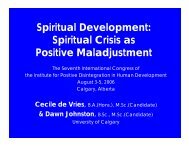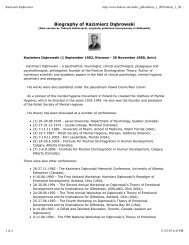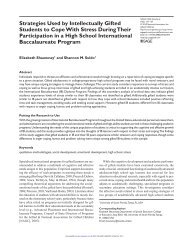Assessing the social and emotional needs of the gifted. - Kazimierz ...
Assessing the social and emotional needs of the gifted. - Kazimierz ...
Assessing the social and emotional needs of the gifted. - Kazimierz ...
Create successful ePaper yourself
Turn your PDF publications into a flip-book with our unique Google optimized e-Paper software.
Printing<br />
http://vnweb.hwwilsonweb.com.ezproxy.lib.ucalgary.ca/hww/result...<br />
The H.W. Wilson Company/WilsonWeb / OmniFile Full Text Select<br />
AUTHOR: Karyn L. Gust<br />
TITLE:<br />
<strong>Assessing</strong> <strong>the</strong> Social <strong>and</strong> Emotional Needs <strong>of</strong> <strong>the</strong> Gifted<br />
SOURCE: Gifted Child Today Magazine v19 p38-40 S/O '96<br />
The magazine publisher is <strong>the</strong> copyright holder <strong>of</strong> this article <strong>and</strong> it is reproduced with permission. Fur<strong>the</strong>r reproduction <strong>of</strong><br />
this article in violation <strong>of</strong> <strong>the</strong> copyright is prohibited.<br />
The Children's Self-Report <strong>and</strong> Projective Inventory (Ziffer & Shapiro, 1992) is a relatively new instrument for<br />
assessing <strong>the</strong> <strong>social</strong>/<strong>emotional</strong> functioning <strong>of</strong> all children, including <strong>the</strong> <strong>gifted</strong> <strong>and</strong> talented. The CSRPI is an individually<br />
administered, multi-method inventory for children ages 5-12. Although this instrument was designed for all student<br />
populations, <strong>the</strong> CSRPI has been especially useful in assessing <strong>the</strong> <strong>social</strong>/<strong>emotional</strong> <strong>needs</strong> <strong>of</strong> <strong>gifted</strong> <strong>and</strong> talented students<br />
seen at <strong>the</strong> Ball State University School Psychology Clinic. Many <strong>of</strong> <strong>the</strong> parents <strong>and</strong> teachers <strong>of</strong> <strong>the</strong> <strong>gifted</strong> with whom I<br />
work have found <strong>the</strong> CSRPI useful in better underst<strong>and</strong>ing <strong>the</strong> <strong>social</strong>/<strong>emotional</strong> <strong>needs</strong> <strong>of</strong> <strong>the</strong> students assessed. The<br />
following article consists <strong>of</strong> background on <strong>the</strong> CSRPI <strong>and</strong> one study outlining its use.<br />
THE CHILDREN'S SELF-REPORT AND PROJECTIVE INVENTORY<br />
In its entirety, <strong>the</strong> CSRPI consists <strong>of</strong> eight components utilizing self-report <strong>and</strong> projective measures. These<br />
components include <strong>the</strong> following (Ziffer & Shapiro, 1992).<br />
FOUR DRAWING TASKS<br />
* Color How You Feel: After a brief introduction on what a variety <strong>of</strong> colors symbolize, <strong>the</strong> child is asked to color in a<br />
silhouette <strong>of</strong> a person's body representing him or herself using <strong>the</strong> colors (yellow = happy, red = angry, blue = sad, green<br />
= worried) that best indicate how he or she feels most <strong>of</strong> <strong>the</strong> time.<br />
* Color How O<strong>the</strong>rs Make You Feel: The child is asked to color <strong>the</strong> silhouettes <strong>of</strong> different bodies, each representing an<br />
important person in his or her life, according to how each individual makes him or her feel <strong>the</strong> majority <strong>of</strong> <strong>the</strong> time.<br />
* Draw a Child in <strong>the</strong> Rain: The child is instructed to draw a picture <strong>of</strong> a child in <strong>the</strong> rain, which can indicate how he or<br />
she perceives <strong>and</strong> reacts to environmental stress.<br />
* Kinetic Family Drawing. The child is instructed to draw a picture <strong>of</strong> everyone in his or her family doing an activity<br />
toge<strong>the</strong>r, which aids in underst<strong>and</strong>ing how <strong>the</strong> child perceives his or her family.<br />
TWO SELF-REPORT MEASURES<br />
* Critical Items: The child is asked to respond to a series <strong>of</strong> 40 statements that indicate serious clinical concerns.<br />
Examples <strong>of</strong> <strong>the</strong>se concerns include, but are not limited to: self-esteem, sadness/depression, anger/hostility, family<br />
relationships, peer relationships, view <strong>of</strong> school, <strong>and</strong> coping ability.<br />
* Perceived Competence: The child is asked to respond to 30 items that indicate <strong>the</strong> child's view <strong>of</strong> his or her<br />
effectiveness, abilities, strengths, <strong>and</strong> weaknesses.<br />
TWO VERBAL PROJECTIVE TASKS<br />
* Sentence Completion: The child is asked to finish a series <strong>of</strong> sentences, which can total 45, that have beginnings<br />
but no endings. Responses to <strong>the</strong>se sentences can provide insight into a child's thoughts, attitudes, outlook, perceptions,<br />
<strong>and</strong> feelings about a variety <strong>of</strong> topics (e.g. family, school, peers).<br />
* Projective Story Cards: The child is shown a variety <strong>of</strong> cards with pictures on <strong>the</strong>m. He or she is asked to tell a short<br />
story about each picture describing <strong>the</strong> situation <strong>and</strong> what <strong>the</strong> people involved are thinking <strong>and</strong> feeling. These stories can<br />
provide information about <strong>the</strong> child's self-image, parental or sibling relationships, thoughts <strong>and</strong> feelings about school,<br />
peer relationships, view <strong>of</strong> his or her teacher <strong>and</strong> self as a student.<br />
A CASE STUDY: CHRIS<br />
BACKGROUND INFORMATION<br />
Chris is a 7-year, 5-month-old male residing with his natural parents <strong>and</strong> 4-year-old sister. His parents referred him<br />
for evaluation for an assessment <strong>of</strong> his learning capabilities. Specifically, <strong>the</strong>y were interested in whe<strong>the</strong>r Chris would<br />
qualify for a <strong>gifted</strong> <strong>and</strong> talented program <strong>and</strong> which schools in <strong>the</strong>ir area would provide <strong>the</strong> best services. His mo<strong>the</strong>r<br />
reported that Chris' language development milestones were advanced; he spoke his first word at approximately seven<br />
months old <strong>and</strong> put several words toge<strong>the</strong>r at one year <strong>of</strong> age. She fur<strong>the</strong>r indicated that Chris has repeatedly tried to<br />
accomplish tasks before he was ready, such as "trying to walk before he was physically able."<br />
At <strong>the</strong> time <strong>of</strong> evaluation, Chris was attending a private school where he received regular first-grade instruction with<br />
supplemental assignments given to him by his teacher. His parents reported that Chris saw <strong>the</strong>se extra projects as "dumb<br />
<strong>and</strong> boring" <strong>and</strong> subsequently disliked school. Chris corroborated this by stating that he tries to miss school by getting<br />
ready slowly.<br />
His parents indicated that Chris is an "intense" child who can be "overly sensitive" about <strong>the</strong> welfare <strong>of</strong> himself <strong>and</strong><br />
1 <strong>of</strong> 3 11-04-08 5:01 PM
Printing<br />
http://vnweb.hwwilsonweb.com.ezproxy.lib.ucalgary.ca/hww/result...<br />
o<strong>the</strong>rs. He repeatedly worries <strong>and</strong> talks about "very adult things," such as war, ecology, pollution, <strong>and</strong> death. He also<br />
becomes very upset if he feels o<strong>the</strong>rs are talking about or "picking on" him. Chris engages in highly imaginative activities,<br />
such as pretending he was Batman for several months at <strong>the</strong> age <strong>of</strong> four, engaging in detective activities, <strong>and</strong> working on<br />
building a trap for his room (i.e., a cap gun would go <strong>of</strong>f when his door opened). He also "goes on binges where he<br />
focuses on an idea or activity for weeks on end." For example, he had a previous interest in watches (i.e., different kinds,<br />
functions). When disciplining Chris, his parents stated that <strong>the</strong>y must provide him with <strong>the</strong> reasoning behind rules before<br />
he will comply. Chris was additionally characterized as having a few, close friends.<br />
TEST/BEHAVIORAL OBSERVATIONS<br />
When Chris walked into <strong>the</strong> clinic, his gregarious personality was very much evident. Chris had been told by his<br />
parents that he would spend <strong>the</strong> next two Saturdays in this place, "to find out what things were easy for him to do <strong>and</strong><br />
what things were more difficult for him to do." To translate, he was going to be assessed for <strong>gifted</strong>ness. In order to<br />
immediately impress <strong>the</strong> examiner with his knowledge, Chris sat down in <strong>the</strong> waiting area <strong>and</strong> told me about <strong>the</strong> novels<br />
he was currently reading, which included The Silver Chair <strong>and</strong> The Very Scary Almanac. Following this brief discussion, I<br />
informed Chris that I would need to talk with his parents for a short time to clarify certain information. Chris indicated<br />
that this was underst<strong>and</strong>able, so he remained in <strong>the</strong> waiting area as his parents <strong>and</strong> I moved to a room across <strong>the</strong> hall.<br />
However, it was during this interview that Chris' nature changed. First, he became curious about what was going on<br />
without him <strong>and</strong> repeatedly tried to eavesdrop on <strong>the</strong> interview. When that failed, Chris <strong>the</strong>n became angry with both his<br />
parents <strong>and</strong> me for talking behind his back.<br />
When testing began, I decided to build rapport with Chris by asking him to complete <strong>the</strong> drawing tasks on <strong>the</strong> CSRPI.<br />
During <strong>the</strong> initial administration <strong>of</strong> <strong>the</strong> "Color How You Feel" <strong>and</strong> "Color How O<strong>the</strong>rs Make You Feel" drawing tasks <strong>of</strong> this<br />
instrument, Chris scribbled red on <strong>the</strong> page <strong>and</strong> spoke loudly about why he was angry with <strong>the</strong>se people (i.e., "<strong>the</strong>y yell at<br />
me," "<strong>the</strong>y take my stuff," <strong>and</strong> "<strong>the</strong>y send me to my room"). He also informed me that if he had ano<strong>the</strong>r silhouette to<br />
color on <strong>the</strong> "Color How O<strong>the</strong>rs Make You Feel" task, he would color me <strong>the</strong> deepest shade <strong>of</strong> red. And, perhaps more<br />
startling was his family drawing, because it depicted his parents pointing a gun towards him. When questioned about <strong>the</strong><br />
drawing, Chris stated that his parents had not done this yet, but "probably planned to" in <strong>the</strong> near future. The drawings<br />
were greatly influenced by Chris's anger that his parents <strong>and</strong> I were talking about him. When <strong>the</strong>se drawings were<br />
readministered during <strong>the</strong> second testing session, <strong>the</strong>y did not display anger to <strong>the</strong> same degree. For example, Chris'<br />
colors were primarily yellow, <strong>and</strong> he completed a more traditional family drawing, that <strong>of</strong> his family watching television.<br />
INTERPRETATION OF THE CSRPI<br />
During <strong>the</strong> first day <strong>of</strong> testing, Chris' behavior <strong>and</strong> drawings indicated <strong>the</strong> possibility <strong>of</strong> a heightened level <strong>of</strong><br />
overexcitability. Dabrowski initially addressed this characteristic which has since been applied to <strong>the</strong> <strong>gifted</strong> <strong>and</strong> talented.<br />
Overexcitabilities have been referred to as "<strong>the</strong> enhancement <strong>and</strong> intensification <strong>of</strong> mental activity much beyond <strong>the</strong><br />
ordinary" (Piechowski, 1991, p. 287). The facets <strong>of</strong> overexcitabilities demonstrated by Chris were intensity <strong>and</strong> <strong>emotional</strong><br />
sensitivity. Piechowski (1991) described this phenomenon as:<br />
The intensity <strong>of</strong> <strong>emotional</strong> reactions,<br />
especially in children,<br />
may sometimes be difficult to<br />
underst<strong>and</strong>, especially when<br />
<strong>the</strong>y strike seemingly out <strong>of</strong> <strong>the</strong><br />
blue <strong>and</strong> <strong>the</strong> child is strongly<br />
upset over "nothing." It requires<br />
considerable patience <strong>and</strong><br />
knowledge <strong>of</strong> <strong>the</strong> child to see<br />
that this "overreaction" comes<br />
from <strong>the</strong> child's sensitivity <strong>and</strong><br />
need for his or her own order <strong>of</strong><br />
things to be preserved (pp. 287,<br />
289).<br />
Chris' frustration with being left out <strong>of</strong> my conversation with his parents manifested itself in anger towards those<br />
around him. Therefore, it was necessary to allow time for Chris to deal with his sensitivity <strong>and</strong> for me to regain<br />
perspective.<br />
Chris also completed <strong>the</strong> o<strong>the</strong>r portions <strong>of</strong> <strong>the</strong> CSRPI. His responses on <strong>the</strong> perceived competence scale indicated that<br />
Chris feels very competent in academic <strong>and</strong> <strong>social</strong> endeavors. Projective story cards <strong>and</strong> sentence completion responses<br />
stressed his dislike for school. For example, when completing <strong>the</strong> sentence "Something I will never do is," Chris stated<br />
"set my school on fire even though I hate school."<br />
SUMMARY<br />
For <strong>the</strong> parents <strong>and</strong> teachers I work with, <strong>the</strong> CSRPI has been a useful tool in gaining insight into <strong>the</strong> <strong>social</strong> <strong>and</strong><br />
2 <strong>of</strong> 3 11-04-08 5:01 PM
Printing<br />
http://vnweb.hwwilsonweb.com.ezproxy.lib.ucalgary.ca/hww/result...<br />
<strong>emotional</strong> world <strong>of</strong> <strong>the</strong>ir students. Awareness <strong>of</strong> this <strong>and</strong> o<strong>the</strong>r potential ways to gain insight into <strong>the</strong> child's world can aid<br />
in one's appreciation for considering <strong>the</strong> <strong>social</strong> <strong>and</strong> <strong>emotional</strong> <strong>needs</strong> <strong>of</strong> <strong>the</strong> <strong>gifted</strong>. In <strong>the</strong> case <strong>of</strong> Chris, <strong>the</strong> CSRPI allowed<br />
me to identify his potential overexcitabilities <strong>and</strong> intensity <strong>of</strong> feelings about school. But, more importantly, through <strong>the</strong><br />
CSRPI, I was able, for a brief period <strong>of</strong> time, to enter <strong>the</strong> life <strong>of</strong> one <strong>gifted</strong> child.<br />
Added material<br />
REFERENCES<br />
Piechowski, M.M. (1991). Emotional development <strong>and</strong> <strong>emotional</strong> <strong>gifted</strong>ness. In N. Colangelo & G.A. Davis (Eds.),<br />
H<strong>and</strong>book <strong>of</strong> <strong>gifted</strong> education (pp. 285-306). Boston: Allyn & Bacon.<br />
Ziffer, R.L., & Shapiro, L.E. (1992). Children's self-report <strong>and</strong> projective inventory. Narberth, PA: Psychological<br />
Assessment Services.<br />
WBN: 9624504914006<br />
3 <strong>of</strong> 3 11-04-08 5:01 PM


